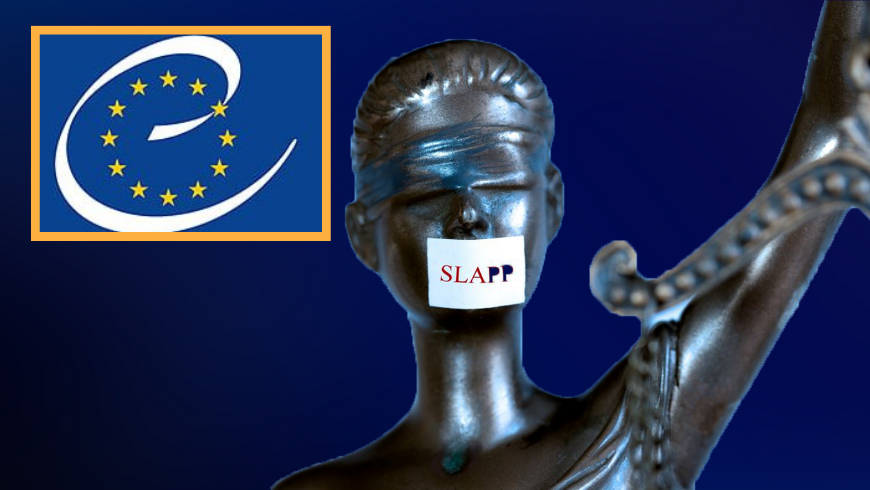Statement | CoE’s Recommendation represents a significant milestone in the fight against SLAPPs | Coalition against SLAPPs in Europe

The Netherlands Helsinki Committee, as a member of the Coaliation Against SLAPPs in Europe (CASE), welcomes the Council of Europe’s Recommendation on SLAPPs, approved by the Committee of Ministers on Friday, 5 April 2024. The Recommendation is comprehensive and, if genuinely implemented, could significantly limit the damage caused by SLAPPs. Read the full statement.
The Recommendation establishes robust and authoritative standards that member states must meet in order to ensure compliance with their human rights obligations. It will prove crucial as European Union member states transpose the new anti-SLAPP directive into national law, and provide a roadmap for non-EU members of the Council of Europe (CoE) to introduce effective anti-SLAPP protections of their own
The publication of the Recommendation follows a two-year drafting process through the Committee of Experts on Strategic Lawsuits Against Public Participation (MSI-SLP), comprising representatives from Member States and independent experts. CASE has greatly welcomed the transparency and inclusiveness of this process, which included a public consultation on a draft recommendation in July 2023.
EU member states should utilize this Recommendation as well as an important report by the Parliamentary Assembly (PACE) published in January as vital benchmarks when introducing domestic anti-SLAPP laws. As CASE has already laid out, it is crucial that the EU Directive be understood as establishing minimum standards for anti-SLAPP protection. The Recommendation helps flesh out these standards and provides the detail needed for anti-SLAPP laws to provide meaningful protection.
CASE has closely reviewed the Recommendation and identified important strengths that should serve as a signpost in developing robust anti-SLAPP protections at the national level. At the same time, we have indicated several ambiguities in the text – in particular in relation to the early dismissal mechanism – that could, if interpreted in a restrictive manner, hinder efforts to counter the use of SLAPPs. Member states should clarify and fortify these provisions to ensure the law is comprehensive, leaving no room for exploitable loopholes or circumvention.
CASE will be publishing a full analysis of the Recommendation – along with constructive recommendations of our own as to how its provisions should be transposed into national law – in the coming weeks. We will also be publishing our own top-line standards, based on the Recommendation and the PACE report, that member states must meet in order to ensure effective protections against SLAPPs
*********************************************************************************************************
CoE Recommendation: Strengths/Weaknesses
Key points
- The Recommendation provides a far more robust and detailed set of standards than the EU Directive that will prove crucial during transposition – and will help push non-EU member states to introduce meaningful anti-SLAPP protections of their own. This is particularly significant in relation to the provision that SLAPP victims be “fully compensated for damages incurred as a result of the SLAPP” – a provision that was ultimately watered down in the final EU directive.
- The Recommendation will prove particularly important in assisting courts and national authorities in identifying SLAPPs, thanks to a long list of “SLAPP indicators”. This will prove crucial in the interpretation of Article 4(3) of the Directive, and in pushing member states to ensure any early dismissal mechanism works to filter out all abusive claims – not just those found to be “manifestly unfounded”.
- There are some ambiguities in relation to the early dismissal mechanism that could limit the application of this crucial measure – though potential exists, given certain apparently conflicting standards, for these provisions to be interpreted in such a way as to ensure the effective operation of the mechanism.
Strengths
- The Recommendation defines “litigation” to include legal threats and “public participation” to include a wide variety of activities covered by the right to freedom of assembly and association, as well as free expression. This includes the right to engage in peaceful protests and boycotts, both of which have been threatened by SLAPPs in Europe in recent years.
- The Recommendation extends many of the principles that underpin the EU directive to non-EU members of the Council of Europe: this includes, crucially, a recognition of the need for early dismissal and provision for the restitution of costs – as well as protection from third country SLAPPs. It also fleshes out parts of the directive that are left undefined or which are lacking in detail: making clear, for example, that in order to be an effective deterrent any penalties must be proportionate to the resources available to the claimant. The most important provision in this regard is Para 41 on compensation for damages – a provision that was ultimately included in the Directive only as an example of “other appropriate measures” that might stand in as a substitute for penalties.
- Paragraph 8 includes a wide number of SLAPP indicators, which will be crucial in broadening the understanding of what constitutes “abuse” for the purposes of the directive. These indicators – and the recognition that “the more of them that are present or the more acute the behaviour, the more likely the legal action can be considered as a SLAPP” – will be crucial in building clarity around what constitutes a SLAPP and helping courts (and other national authorities) identify them.
- Crucially, in addition to the somewhat ambiguous threshold test recommended (see below), the recommendation says that courts “should have the legal powers to make an assessment of the indicators in paragraph 8 and fully or partly discontinue the claims”. This is important, as it counters the rigid dichotomy established by the EU directive between “manifestly unfounded” and “abusive” proceedings against public participation – making clear that if a lawsuit is found to be an abusive effort to shut down public participation it should be removed from the court.
- The recommendation holds that member states should stay proceedings until a final decision on the anti-SLAPP application is taken and that the claimant should not be allowed to amend the pleadings in the proceeding with the aim of avoiding a dismissal order. Both are crucial protections for SLAPP defendants. In particular, a stay of proceedings would prevent the claimant from weaponising certain resource-intensive procedures – such as the disclosure/discovery process – while the anti-SLAPP motion is pending a decision.
Weaknesses
- The recommendation says that early dismissal provisions “should require claimants targeting public participation to establish a reasonable cause of action at the earliest possible stage in proceedings in order to advance to trial”. It is important to emphasise that such a threshold test is on its own far too low to provide meaningful protections for SLAPP targets. As the explanatory note says, “Member States should recognise that some actions that can be classified as SLAPPs may be arguable in law”.
- Paragraph 27(a) recommends that the conditions for the admissibility of applications for early dismissal could include judicial consideration of “whether the claim is unlikely to succeed at trial”. Given the demonstrable limitations of the above threshold test, CASE recommends that member states understand “reasonable cause of action” in light of 27(a) to mean a likelihood of prevailing at trial.
- Paragraph 27, however, presents some ambiguity of its own: namely, that in order to be admissible for early dismissal, a claim may have to show both that it is unlikely to succeed at trial and that it is abusive in light of the SLAPP indicators. CASE recommends that the application of any national anti-SLAPP law is not made conditional on the lawsuit in question being identified as “abusive”: while the indicators in Para 8 are helpful, this would still require courts to identify the purpose of the filer (specifically, that the claimant seeks to misuse or abuse the legal process to prevent, inhibit, restrict or penalise free expression on matters of public interest and the exercise of rights associated with public participation”). Such a subjective enquiry into the mind of the filer is fraught with difficulties and would create uncertainty in the operation of the early dismissal mechanism; this would in turn undermine efforts to counteract the chilling effect of legal intimidation and deter would-be SLAPP claimants. The problems presented by this subjective test are compounded where the defendant has the burden of establishing the intent of the filer: this risks driving up costs to the point where invoking the anti-SLAPP mechanism itself becomes a gamble for the defendant.
- CASE notes, however, that Paragraph 31 suggests a more objective approach to the identification of abuse, recommending that a defendant merely be required to provide evidence that a “number of the SLAPP indicators are present”.
- The provisions on legal aid/support are a disappointing fudge, particularly given the recognition in the case of Steel and Morris v UK that a lack of legal aid led to a violation of Article 6 of the ECHR. CASE notes in relation to Paragraph 51 that if it’s “necessary” to protect the rights of the defendant, access to free legal assistance should be guaranteed by member states – not just “considered”.


